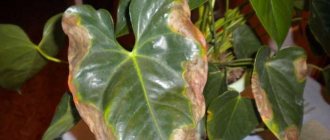- May 4, 2019
- Other states
- Oleg Petrov
Knowing what violet diseases are (in the photographs) and their treatment is important for everyone who grows houseplants. Violets, so beloved by many flower growers in our country, like most other indoor plants, are susceptible to attacks from pests, and also suffer from improper care for them, and are difficult to tolerate bacterial, fungal and viral illnesses. In this article we will tell you in detail what needs to be done in order not to lose the plants decorating our windowsill, what you should pay attention to in order to detect the problem as early as possible. All this will help you not only save violets from death, but also take care of them, restoring their former beauty and health.
Flowering problems
Understanding photographs of violet diseases and their treatment is necessary for everyone who cares about the beauty of their home plants. Especially often when breeding violets one has to deal with a violation of the development of the rosette or a lack of flowering.
It is worth knowing what the reasons for this are. In reality there are not many of them. These are pests that settle in the soil or indoor plants themselves, the consequences of improper care or diseases that have a different danger and nature.
Inexperienced and novice gardeners most often have plants that suffer and develop incorrectly precisely because of ill-organized care. Soon traces of improper watering, incorrectly selected fertilizers, or insufficient lighting appear on the foliage.
Please note that in the absence of sufficient light, the new generation of foliage appears smaller and duller, especially when compared to the previous one. The edges of the leaf blades characteristically bend upward, and the petioles lengthen. If the plant is placed in a well-lit place, it quickly returns to normal. Especially if it is on a windowsill protected from drafts.
One of the most common causes of violet disease (photo presented in this article), which is why the plant stops blooming at home, is salinity or increased acidity of the soil. As a rule, this occurs due to improperly selected soil. In this situation, the formation of peduncles slows down significantly, and in some cases may stop altogether, and the leaves begin to curl. Similar symptoms occur with overwatering, nitrogen deficiency, or other examples of mineral imbalances.
Usambara violets, which are also called Saintpaulia, popular among indoor plants, have increased sensitivity not only to the quality of water that ends up in the soil, but also to its temperature. All flower growers need to closely monitor this. After all, these are one of the most common indoor plants in our country. This means that many people face similar problems regularly. They must recognize violet diseases from photographs; their treatment must be effective.
The appearance of light spots on the leaves should remind the grower that he is watering them incorrectly and something urgently needs to be changed. This unhealthy plant response is a sign that the water is too hot or too cold. This can also occur due to sun exposure to the wet surface of the leaf. Therefore, experienced flower growers strongly recommend using only warm water and watering Uzambara violets in the evenings, when the likelihood of burns is reduced to zero.
Causes of diseases in violets
Experienced gardeners know that it is possible to protect a plant from diseases by providing it with optimal conditions that are close to natural. It is necessary to organize proper care at home.
Violets are heat-loving plants, they feel good at temperatures of +20...+25°C, and do not tolerate drafts and temperature changes. In a cold room, violets stop growing, and frequent watering under such conditions leads to rotting of the stem and roots. Heat also has a bad effect on the flower, weakening it, which leads to illness in indoor violets.
When exposed to direct sunlight, the tender leaves of the plant get burned, wither and turn yellow. Therefore, the light in the room should be diffused and dim.
The soil must be free from pathogenic microbes and pests, so you should not take soil for violets from the garden. The soil for violets should be nutritious and light, providing air access to the roots and the drainage of excess moisture. Heavy, dense soil mixtures are not suitable for the Saintpaulia root system, causing it to rot.
Violet likes moderate moisture rather than heavy watering; it should not be moistened with cold water. To provide the guest from the tropics with optimal air humidity, the pot with the plant is placed in trays with moistened gravel or moss, or the air is freshened with a sprayer.
Dangerous pests
Diseases and pests of violets cause great damage to flower growers:
- mealybug;
- mites;
- scale insects;
- nematodes;
- thrips;
- aphid.
Insects can be brought in with garden soil, purchased plants, and cut flowers. Therefore, plants need to be inspected regularly, and if questions arise about why spots and other symptoms of the disease appear on violet leaves, treatment should be started immediately.
Ticks feed on the juice of violet leaves; their presence is indicated by the following signs:
- thin cobwebs on flowers or leaves that turn brown over time, dry out and fall off (spider mites);
- young leaves in the center of the rosette turn yellow and thicken (cyclamen mite);
- the leaves of the plant curl inward, subsequently they wither and fall off, the plant may die (plate mite).
To combat ticks, acaricides are used - Apollo, Neoron, Fitoverm.
Scale insects and false scale insects look like tubercles on the underside of the leaf, having a brown, green or yellow color. Attaching to the leaf along its veins, insects suck out the juices from the plant and produce a sticky secretion on which the sooty fungus multiplies well.
Adults must be removed from plants mechanically by soaking a swab in a soap solution, since they are not susceptible to chemicals. After removing them, the violet bush must be treated with solutions of Aktara, Bankol, Mospilan or other insecticides. The window sill, shelf, and window glass, which may contain scale insect larvae, should be treated with insecticides.
Thrips are small insects that look like elongated flies. They infect plants not only by feeding on their sap, but also by transmitting various flower diseases. Thrips are black, brown or gray in color and settle on the lower part of the leaves. After a while, you can see light dots and stripes on the top, then the leaves become deformed and fall off, the flowers crumble.
In the fight against thrips, insecticides such as Fitoverm, Actellik, Confidor are used, which are applied at the root and used for spraying. Violet leaves should be washed thoroughly before processing. If thrips were noticed on one plant, then you need to treat all the specimens in the house, because thrips migrate quickly and infect flowers.
Nematodes are small, up to 2 mm, worms that live in the ground and feed on plant roots. Signs of root infection by nematodes:
- roots are brown, black;
- the stem of the plant is elongated and thickened;
- the petioles of the lower leaves are short, the upper leaves have none;
- the leaves are compacted and dark green, curling inward;
- roots are brown, dark in color with thickenings (galls).
There are no effective means of destroying worms, so to prevent infection, peat or crushed dried marigold flowers are added to the soil. You can use an infusion of marigolds or peat to water violets.
The mealybug, or hairy louse, is visible on the plant with the naked eye. By sucking juice from shoots, leaves, and buds, parasites slow down the development and growth of the plant. The insect can be distinguished by its characteristic whitish waxy coating. A white coating similar to cotton wool is visible on the plants, on which sooty fungus multiplies.
If the plant is only slightly affected, then use a cotton swab soaked in soapy water to clean it from insects and their sticky secretions. You need to prepare a solution of green soap (15 g per 1 liter of water), spray the violets, then re-treat them 2 more times after 7-14 days.
Aphids suck sap from plant leaves, slowing their growth and inhibiting flowering. Aphid colonies are clearly visible; they prefer to settle on the underside of leaves. The danger of aphids is that they carry viral diseases, further infecting a weakened plant. To combat aphids at the very beginning of infection, it is enough to remove the damaged parts of the violet and wash it with warm soapy water.
Root and leaf rot
Saintpaulia is at serious risk when pruning, dividing plants and replanting the apical part of the rosette. In this case, the stems may simply rot. This is a very common disease of violets. Its treatment should be well known to all gardeners.
The reasons for this condition may lie in excessive watering after the soil has been dry for a long time, or pests. When putrefactive bacteria settle on damaged tissues, damage to the stem and roots occurs especially quickly.
Symptoms of this disease of violets (photo presented in the article) may be the loss of the rosette’s natural color or leaf turgor, as well as the rapid withering of leaf blades and petioles. If at least one of the symptoms is severe, urgent measures must be taken. All lovers of indoor plants should be well aware of the diseases of violets and their treatment. Damaged tissue should be urgently removed, and the Uzambara violet itself should be rooted using a healthy leaf, from which new rosettes are formed.
Children, young rosettes and rooted leaves can often be affected by brown rot. In this case, the brown color appears at the very base of the stem, and the stem itself becomes thinner and softer. In this case, whitish threads of mycelium are formed on the soil. If you do not take urgent measures, having learned about the disease of violets from photographs, and do not treat them, the disease will spread to plants located in the neighborhood.
In this case, to prevent this condition, Saintpaulia should be treated with a fungicide, irrigating the area under the stem with Fitosporin or another similar chemical.
Dull coloring and wilting of leaves can also be observed with the development of root rot. When the plant is removed from the soil, you will notice brownish roots that are infected with harmful spores of a dangerous fungus. They begin to quickly disperse, especially in humid environments, and multiply. If the acidity of the soil is low, this also contributes to an infection that is dangerous for Uzambara violet.
It is believed that one of the most effective measures to combat this disease is to reduce the frequency of watering. At the same time, rare portions should be as plentiful as possible. For the prevention and treatment of violet disease, the photographs show a bright example of a flower, it is recommended to use root treatment with “Fitosporin”. A soil that does not retain moisture too much is also recommended in such situations.
It is worth remembering that gray rot is a dangerous disease for indoor plants. It can cause the green parts to weaken and liquefy, leaving a noticeable fluffy coating on the surface. All cuttings, leaves with signs of disease and leaf blades should be removed, not allowing them to fall on the ground. In order to reduce the likelihood of developing this disease in winter, you should stop spraying sockets, prevent the air in the room from becoming too humid, and water the Saintpaulia so that condensation does not form and moisture does not stagnate.
Among the effective chemical agents, it is recommended to use Fundazol.
Gray rot on violets and its treatment
Other indoor plants suffer from this fungal disease, not just Saintpaulia. The infection affects the tissue of young seedlings, leaves, flowers and buds. The plant turns brown, rots, or becomes covered with a gray-brown coating. The violet becomes covered with brown spots, which quickly spread throughout the plant. Typically, this type of parasite penetrates weakened plants through mechanical damage. In this case, you need to spray with a copper-soap solution (dilute 20 g of liquid potassium soap and 2 g of copper sulfate in 1 liter of water). In order to avoid infection, experts recommend carrying out preventive procedures. Feed with fertilizers and microelements, which significantly increase the plant’s resistance.
Causes of spots on leaves
The causes of violet leaf disease (photos as an example are posted in the article) can be very different. It is important to establish them before taking any action, since this will determine what methods of therapy, care and prevention should be used.
Among the most common reasons is a draft. Among the most dangerous are pests. To determine the cause of violet leaf disease (in the photo you can study what it may look like) you will need a magnifying glass or magnifying glass. Through it you should carefully examine the affected leaf. Only after careful analysis and study will it be possible to understand how to deal with it.
If black dots appear on the surface, this will most likely indicate a fungal infection. If, upon magnification, small through holes are found, it means that insects are eating it. By carefully studying the leaves, you can find colonies of insects, cobwebs, and other signs on them that indicate a particular disease. When you finally decide where the spots on the leaves came from, how to treat violet disease will immediately become clear.
Treatment methods
Many violet owners are interested in how to fight diseases. To eliminate infections, special solutions can be used to locally treat the plant. It is advisable to use such remedies for fungal diseases.
Effective drugs include the following:
- "Topaz";
- "Sulfarid";
- "Trichoderma";
- "Tiovit Jet";
- "Fundazol".
It is advisable to use such products against rust, powdery mildew, and in the fight against certain types of pests. Treatment must be carried out in strict accordance with the instructions that come with the medicine.
To save the flower from death, it is recommended to remove damaged areas. This is easiest to do if the violet leaves are affected by the disease. Diseased cuttings are cut off, and healthy ones are wiped with warm water. In this case, liquid should not get on the stem.
Replacing the top soil layer can help with treatment, especially if the violet roots are affected. It is necessary to remove 2-3 cm of soil without removing the flower itself. This must be done with caution. Rotten shoots are removed, as this prevents the proliferation of pathogenic microorganisms. After this, the required amount of fresh enriched soil is added.
During the treatment period, it is recommended to keep the flower at elevated temperatures and moderate humidity. The plant should be exposed to sunlight rather than standing in the shade. This creates optimal conditions for activating the violet’s immune processes and increases the likelihood of recovery.
Powdery mildew
This is one of the most common diseases of violets (pictured). Treatment should begin when Saintpaulia is affected by harmful fungi. Outwardly, it may look like flour scattered over the whisks and leaf plates. It is worth noting that Saintpaulia infection occurs with the help of special spores that are found in the soil.
Remember that this disease affects violets that have been weakened as a result of transplantation, as well as plants that are too young or too old.
In this case, as a preventive measure, it is recommended to protect the sockets from strong temperature fluctuations, use fertilizing and water in a timely manner. If the plant is already affected by the disease, it should be treated with a fungicide.
Why do leaves curl inward?
The best varieties of violets - varieties with names
It happens that violet leaves curl for unknown reasons. This problem can cause the death of the flower. Why do violet leaves curl inward during the development of Saintpaulia:
- excess nutrients in the substrate;
- too frequent watering;
- pests that have settled under the leaf;
- incorrect transplantation of the sprout;
- inappropriate level of lighting.
The leaves are curling
In order for the leaf plate to stop deforming, you need to take a close look at the plant and adjust the maintenance conditions.
Fusarium
This is one of the most dangerous diseases for Uzambara violets. It first affects the root system, and then spreads through the vessels to the petioles, stem, and leaf blades.
At this stage of the disease, most of the old foliage withers in the lower level area, the edges and stems become too watery, and eventually die completely. The rapid death of the plant in this case is facilitated by its significant weakening after flowering, lack of fertilizers, and low temperature (up to 16 degrees).
It is worth noting that it is quite possible to effectively combat fusarium. You should urgently isolate the diseased Saintpaulia from other violets. Ideally, destroy the affected specimen along with the soil. Treat the pot with fungicide or copper sulfate. As a preventive measure, you should also establish an irrigation regime using a Fitosporin solution. This procedure should be repeated monthly.
Why do the leaves become covered with a white coating like flour?
White bloom on violets is common, since the disease that affects the plant is very common. A coating appears on the leaves, which from a distance looks like flour sprinkled on greens. This is powdery mildew. Reasons for its appearance:
- high indoor humidity;
- incorrect temperature in the room;
- excessive watering;
- poor care of indoor flowers;
- the presence of infected plants within a radius of several meters. Even touching edges can transmit the disease to a healthy specimen.
Powdery mildew
Note! First, plaque covers the lower tiers, so it is sometimes difficult to identify the problem in time.
Late blight
On indoor plants, this disease manifests itself in the form of drying out or brown spots on the leaves. The violet disease develops quickly, spreading throughout the entire rosette. It withers as its tissues undergo necrosis. Even after watering, the elasticity of the foliage is not restored.
When the apical part of the rosette is not affected, it is cut off, trying to re-root, treating it with an antifungal drug, and then cutting off all painful areas.
Please note that a healthy cut should be light green in color. The remaining part of the socket should be destroyed.
What does it mean if violet leaves become limp?
A situation can become dangerous for the life of a flower when the stem begins to lose its elasticity, and the above-ground part of an indoor flower suddenly becomes sluggish. There may be several reasons for this decline:
- untreated sections have a fungal infection;
- serious mechanical damage;
- the appearance of pests that feed on Saintpaulia juice;
- incorrect temperature regime for the plant;
- diseases late blight and fusarium, which are characterized by rust-colored spots.
Note ! If the plant has recently been replanted, the cause may be burnt to the plant root by fertilizers added to the soil. In this case, it is impossible to save Saintpaulia.
The leaves have wilted
The question often arises when a violet has limp leaves, what to do to resuscitate the plant. The best solution would be transplantation. At the time of removing the sprout, all parts of the root and above-ground system can be examined. Remove the soft parts and transplant the rest of the seedling into a new container.
Pests
Often, diseases of violet leaves, as can be clearly seen in the photo, develop due to pests that can cause significant harm to this indoor crop, since both the roots and green parts of the plants are in their immediate area of interest. In addition, they are carriers of diseases.
At home, cyclamen mites become dangerous pests. Infection can only be determined when new leaves appear, when the rosette is inhabited by miniature insects. Because of them, Saintpaulia stops growing, blooming, and becomes smaller. You need to fight them with the help of insecticides, for example, Fitoverma.
Another insidious enemy of these indoor plants is the nematode. These worms penetrate from the soil into the vessels and roots of the plant. By sucking out all the juices, they poison Saintpaulia with toxins and disrupt the supply of tissues. The violet becomes weak and helpless and stops blooming. Stem thickenings appear on the green part of the plant. Bubbles and nodes in which worm cysts develop become clearly visible on the roots.
The easiest way to find aphids is by the sticky secretions on the foliage, as well as by the insects themselves, which live on the petioles and the back of the leaves. You can wash them off with a regular soap solution, just be careful not to over-moisten the soil.
Pale and light leaves
Most varieties of violets grow with beautiful decorative leaves, so it is quite easy to notice when they fade and fade. Find out the reason and quickly adjust the care - then the flower will recover on its own!
- Sucking insects draw out all the juices from the violet, and it fades and withers;
— Nematodes eat the root system, which is why the above-ground part grows weak, sluggish, pale and deformed.
Photo: domashniecvety.ru
Diseases of strawberry leaves: descriptions with photos, treatment
Prevention
There are several tips for preventing Saintpaulia that will help you protect your plants from most possible problems.
Experience proves that the greatest danger is posed by new sockets that the owner has just purchased from a store or greenhouse. These plants must be sent to a kind of quarantine, separated from all other vegetation for the first month. This will protect them from possible infections, and will give the “newbie” the opportunity to acclimatize.
If you already bought it in bloom, then it is better to get rid of the flower stalks. This will minimize the risk of thrips infection. Another rule: before planting, not only the soil, but also the pots should be disinfected; they can also become carriers of all kinds of infections. Immediately create all the necessary conditions for the violet: food, lighting, timely watering. After flowering, when the plant is exhausted, be sure to apply fertilizer.
A set of measures against diseases and pests
There are simple rules of prevention, the observance of which will protect Saintpaulia from infection with fungus and parasites:
- isolation of new flowers from domestic ones for 1-2 months;
- avoiding contact with field plants and fresh vegetables;
- regular treatment with water at room temperature and inspection;
- wet cleaning in places where violets are placed;
- timely processing of pots and pallets;
- compliance with basic care requirements.
Diseases and pests that violets suffer from can be very dangerous and lead to their death. The main condition for good immunity is proper care and maintenance. This will help to grow a healthy and flowering plant.
Rules of care
With proper care at home, you can forget about treating violet diseases forever. Here are the basic rules:
- The plant requires special soil - about three centimeters should remain on the drainage substrate. The soil should be non-acidic and breathable. That is, coarse sand, compost, peat moss, humus. If you have acidic soil, it should be enriched with lime or bone meal.
- It is better to take a pot with a hole in the bottom where drainage should be placed. Violets have small roots, so a small pot will do. In large containers, on the contrary, they may bloom too sparingly.
- Many people pour water only onto the tray, because it is believed that the earth should be constantly moistened, but increased dampness should not be allowed. Violets prefer warm, settled or even boiled water.
Problems due to improper care
Wick watering of violets - how to do it yourself
Most often, signs of disease on violets are associated with improper care, due to which the plant’s immunity is weakened. It could be:
- excessive or insufficient watering;
- incorrect choice of fertilizers;
- non-compliance with temperature and humidity standards, drafts;
- exposure of the flower to direct sunlight;
- high soil PH.
Many flower growers are interested in the question of why violet leaves rise up. Most likely, they are drawn to the light. The cause may also be a dense outlet, low humidity, proximity to batteries or heating devices.
Violets lift their leaves up because they don't have enough light
Why else can a violet lift its leaves up?
- characteristics of the variety;
- improper development;
- poor soil mixture.
Have the violet leaves become smaller, duller and lifted up? This description speaks of a lack of light. If the leaf blades begin to curl inward, this may be the result of mites, as well as excessive watering and an excess of nitrogen fertilizers.
What to do if the violet has limp leaves? The wilting of a flower indicates non-compliance with the rules of watering, lighting, and fertilizing. Yellowing leaves may appear due to water exposure or sunburn. Circular spots form in the cold season when the plant is placed in a draft.
Violet leaves have sunburn
If the leaves turn black, the cause may be excessive soil moisture, prolonged exposure to cold air, or lack of nutrients. White bloom on violets or spots of unusual color are a sign of infection.
If Saintpaulia flowers and flower buds wither, there may be several reasons:
- dry air;
- high temperature in the room;
- lack of lighting;
- low level of soil acidity;
- use of unbalanced fertilizers.
If your homemade violet does not bloom, you will have to correct all the shortcomings in the maintenance - from the pot and the choice of soil to the watering rules.
Basic conditions for growing Uzambian violets
Among flower growers, it is believed that this indoor plant is very capricious and susceptible to diseases. This misconception is easy to refute if you create the right conditions for its cultivation. Considering the conditions of natural growth, it is easy to approach them:
- No need to use large pots.
- They need to be placed on windows facing west or east.
- In order to ensure year-round flowering, it is advisable to use artificial lighting. Soft diffused light from fluorescent lamps is suitable.
- The temperature should not be very high or low. 20–22 °C is considered optimal. Sharp fluctuations are not allowed. You should not place them on a window that is used to ventilate the room.
- The soil for growing should be loose, well-permeable, and not susceptible to acidification. Mixtures of rotted leaves, turf, peat with the addition of coniferous soil have proven well. Various baking powders are often additionally used.
- Watering should not be done abundantly. Do not allow moisture to stagnate in the roots.
- Approximately twice a month it is worth feeding with mineral fertilizers.
- Air humidity is not lower than 50%. But spraying is not advisable. This plant does well among others or on wet pebble soil.
By observing these requirements, you can admire flowering plants throughout the year and not be particularly afraid of violet disease. However, you should know how to treat your pets if they get sick.
Useful tips for preventing diseases in Saintpaulias
In order for Saintpaulias to develop and bloom well, it is necessary to create the correct conditions of maintenance and care:
- Periodically treat the plants under running water at a temperature of up to +40 ° C from a shower horn. At this moment, you should ensure that excess moisture does not get into the soil. Such prevention is reasonable at intervals of 2-3 months. Polyethylene is tied around the trunk of the plant and the flower pot so as not to wash away the soil. After this, the flower is poured out of the shower and left in the bathroom until the leaves are completely dry. Otherwise, white or brown spots may appear on them. Brown ones are caused by sunburn, white ones are caused by hypothermia.
- To combat diseases and insects, use a solution of garlic cloves. To do this, 3 cloves are kneaded and placed in 1 liter of water. Cover the contents with a lid and keep for 24 hours at room temperature. The resulting infusion is diluted with 5 liters of water and the soil and leaf plates of Saintpaulia are treated. After processing, the flowers are blotted to remove any remaining water.
- In difficult cases, it is necessary to use chemical methods to combat diseases and pests of violets. The most common remedy for combating fungal diseases is Fitosporin. To do this, 5 g of insecticide is soaked in 5 liters of water for 30 minutes. Having collected the resulting solution with a medical syringe, thoroughly moisten the soil in the pot. If the drug Fitosporin M is available, spray the plants by dissolving 10 g of powder in 1 glass of water.
- A weak solution of potassium permanganate is used to combat incipient diseases of fungal origin. When cultivating the land, you need to dilute 3 g of potassium permanganate in 5 liters of water and thoroughly pour in the resulting dark mixture.
- Before treating violets against insects, the leaves should be wiped with an alcohol solution to remove immobile specimens and the plaque formed by them.
- To combat ticks, thrips, and aphids, the drug Fitoverm is suitable, an ampoule of which is dissolved in 1 liter of water. If you have a pet shampoo containing permethrin, add 1 teaspoon to the solution. The violets are treated after 3 days, repeating the treatments 4 times.
- To destroy eggs and larvae of ticks, I use the drug Nissoran, using 1 g of product per 1 liter of water. The soil and plants where the offspring are located are sprayed, which die within 1-2 weeks.











